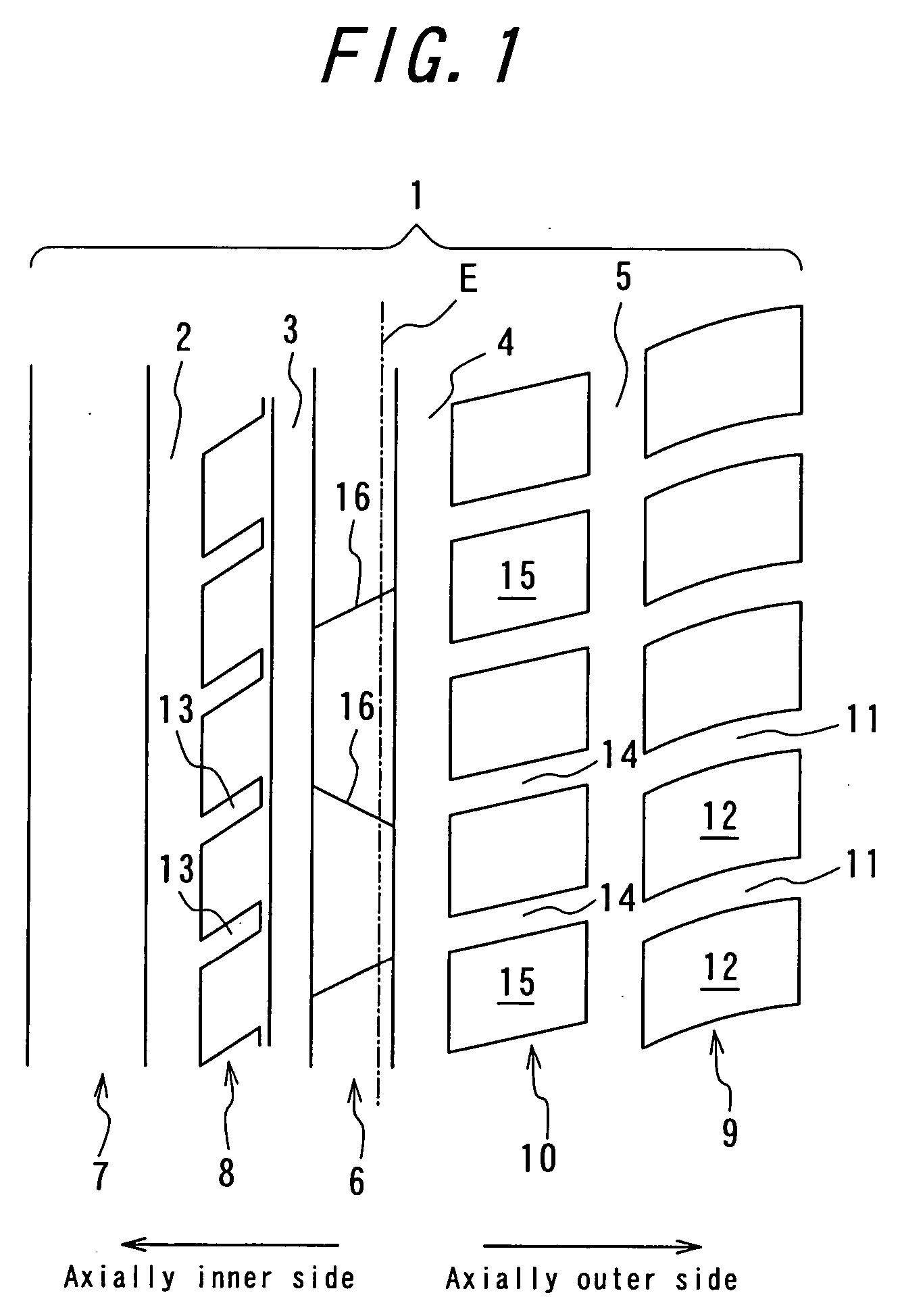Pneumatic tire and tire wheel assembly
a pneumatic tire and tire wheel technology, which is applied in the direction of inflatable tyres, vehicle components, non-skid devices, etc., can solve the problems of premature wear of the tread at increased reaction force, and violent wear of the tread in the axially inner side portion, so as to reduce the reaction force, and enhance the silentness of the vehicle interior
- Summary
- Abstract
- Description
- Claims
- Application Information
AI Technical Summary
Benefits of technology
Problems solved by technology
Method used
Image
Examples
example 1
[0188] Each of example tires and comparative example tires having a tire size of 225 / 55 R16 is assembled onto a rim of 7.0J-16 and filled under an air pressure of 210 kPa and mounted onto a vehicle. The vehicle is actually run at a state of two crewmen riding under a condition that a negative camber of a front wheel is 0.3° and a negative camber of a rear wheel is 0.5°, during which a wear ratio of shoulder land part rows, a speed generating a hydroplaning phenomenon, a vehicle interior noise and a steering stability on a dry road surface are measured.
[0189] Example tire 1 has a tread pattern shown in FIG. 1, in which a slant groove in a second inner land part row has an angle of 45° with respect to a widthwise direction of a tread and an extending angle of a lateral groove in a second outer land part row is 30° and an average extending angle of a lateral groove in a shoulder land part row of an axially outer side is 15°.
[0190] Example tire 2 has a tread pattern shown in FIG. 2, i...
example 2
[0206] Each of example tires and comparative example tires having a tire size of 215 / 45 R17 and a tread pattern shown in FIG. 25 is assembled onto a rim of 7.5J×17 and filled with an internal pressure of 220 kPa, and a camber angle of −0.5° is applied to make a ground contact length of an axially inner side long, and thereafter a slip angle is changed from 0 degree to 5 degrees at a speed of 30 km / h to measure a cornering force generated.
[0207] When a difference of cornering force between 0 degree and 1 degree is Cf1 and a difference of cornering force between 0 degree and 2.5 degrees is Cf2 and a difference between 0 degree and 5 degrees is Cf3, if Cf2 / Cf1 is 2.5 and Cf3 / Cf1 is 5, the cornering force is linearly generated, while if Cf2 / Cf1 is larger than 2.5, the cornering force increases non-linearly at a position having a large slip angle, and if Cf2 / Cf1 is smaller than 3, the cornering force decreases non-linearly.
[0208] In these tires, an integral value of rigidities of the l...
example 3
[0212] Each of example tires and comparative example tires having a tire size of 235 / 45 R17 is assembled onto a rim of 8J×17 under an internal pressure of 210 kPa and mounted onto a vehicle in which a camber angle at a front wheel is −0.4° and that at a rear wheel is −0.6° at a state of two crewmen riding.
[0213] This vehicle is subjected to a wearing test. The test condition is that it is run on an expressway, a general purpose road and a mountain path at a ratio of 50%, 40% and 10% over 20000 km. After the running, a ratio of worn amounts of widthwise central portions of both shoulder land part rows in two front wheels is measured. A case that the ratio is larger than 100 shows that the axially inner side is largely worn, and a case that the ratio is smaller than 100 shows that the axially outer side is largely worn.
[0214] The vehicle is subjected to an acceleration test from a speed of 50 km / h in a pool having a water depth of 6 mm to thereby evaluate a speed generating hydropla...
PUM
 Login to View More
Login to View More Abstract
Description
Claims
Application Information
 Login to View More
Login to View More - R&D
- Intellectual Property
- Life Sciences
- Materials
- Tech Scout
- Unparalleled Data Quality
- Higher Quality Content
- 60% Fewer Hallucinations
Browse by: Latest US Patents, China's latest patents, Technical Efficacy Thesaurus, Application Domain, Technology Topic, Popular Technical Reports.
© 2025 PatSnap. All rights reserved.Legal|Privacy policy|Modern Slavery Act Transparency Statement|Sitemap|About US| Contact US: help@patsnap.com



